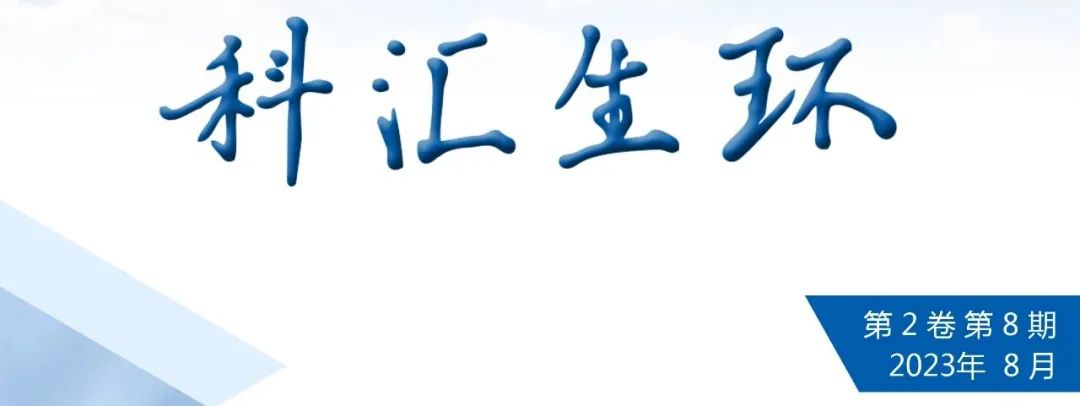
Original Source: Heckman K A, Possinger A R, Badgley B D, et al., 2023. Moisture-driven divergence in mineral-associated soil carbon persistence.Proceedings of the National Academy of Sciences, 120, e2210044120. https://doi.org/10.1073/pnas.2210044120.
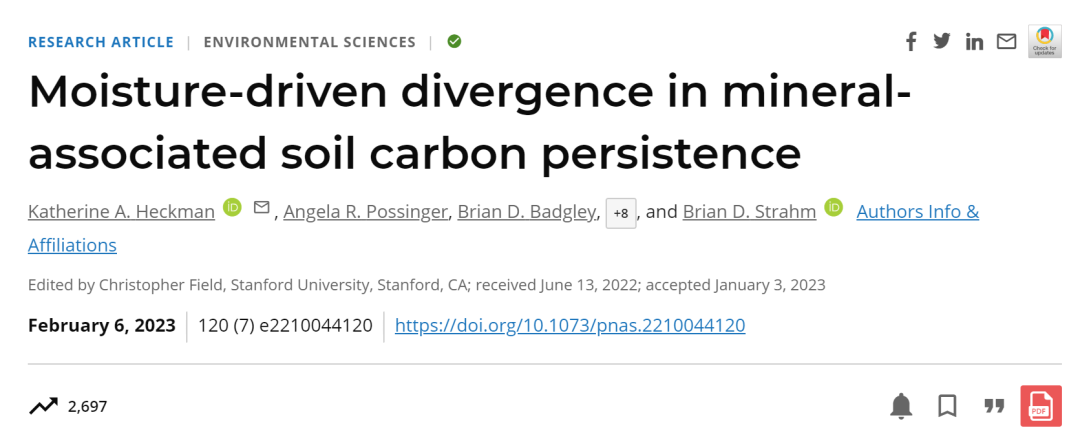
Scientific Background
Mineral-associated organic matter (MAOM) is an important form of soil organic carbon globally. It is generally believed that the association of minerals and organic matter can reduce microbial utilization of organic matter, promoting the persistent stability of soil organic matter (SOM). However, this stability is not absolute. For example, the stability of SOM can be disrupted by the introduction of fresh substrates. Typically, the input of fresh substrates decreases exponentially with increasing soil depth, and correspondingly, the persistence of MAOM (i.e., average system age) also increases. This common pattern reflects a strong interdependence between water availability, substrate input and decomposition, and the persistence of MAOM.
Previous studies have shown that the factors influencing SOM cycling are highly diverse, from large-scale climate change to soil physicochemical properties at the microscale. One of the simplest variables, soil depth, can explain half or more of the variance associated with the abundance and persistence of overall SOM and MAOM. However, soil depth itself is not a direct or mechanical driving factor for the accumulation or turnover of MAOM. The relationship between soil depth and the abundance and persistence of SOM integrates the differentiation of many mechanistic driving factors, including substrate input, oxygen availability, mineral surface reactivity, pH, and other soil characteristics affecting the decomposition rate of SOM. Understanding the relationship between soil depth and SOM is key to linking the SOM profile with the vertical transport of water and solutes, as soil morphological development, net primary productivity, and SOM production directly depend on water availability.
At the continental scale, the climate system can be divided into two categories based on water availability: ① Arid climate zones: evaporation is limited by water supply, with the ratio of mean annual precipitation (MAP) to potential evaporation (PET) being less than 1; ② Humid climate zones: evaporation is limited by available evaporation capacity, MAP/PET > 1. The boundaries between these two systems are sharply contrasted with soil morphology, pH, and the abundance of MAOM. However, how this hydrological climate threshold affects the stability and turnover of MAOM remains unclear, and the relative importance of climate and physicochemical properties in determining continental-scale MAOM persistence is also not well understood.
Scientific Implications
Research Approach: To reveal the relationship between the abundance and persistence of MAOM with water availability, substrate input, and soil physicochemical properties, this study collected surface and subsurface soil samples from 34 sites of the National Ecological Observatory Network in the United States (20 arid climate zones, 14 humid climate zones) (Figure 1) and measured the radioactive carbon abundance [Δ14C (‰)] and organic carbon content [OC(%)] (representing the persistence and abundance of MAOM, respectively). Additionally, physicochemical indicators related to the stability mechanisms of SOM (exchangeable cations, reactive mineral phases of Fe and Al, particle-specific surface area) were measured, and various characterization techniques were used to assess the composition and decomposition state of water-soluble MAOM, providing data support for exploring the driving factors of MAOM abundance and persistence across climate system boundaries.
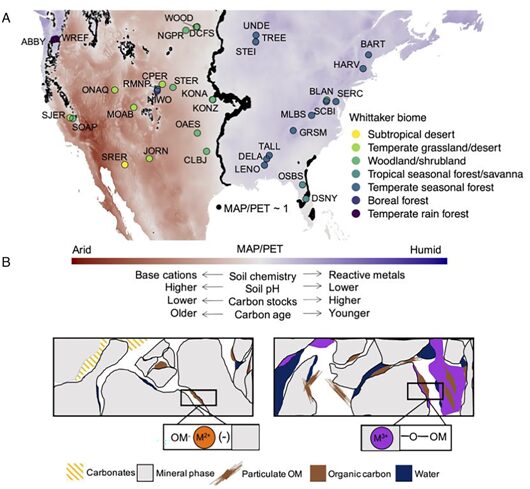
Figure 1 (A) Water availability along the longitudinal gradient of the continental United States (represented by the ratio of MAP to PET), (B) Conceptual model of the differential mechanisms of MAOM formation in different climate zones.
Core Findings: (1) The persistence of MAOM in wet soils is regulated by substrate limitations, while in arid soils it is regulated by moisture transport limitations. As shown in Figure 2, there are significant differences in the relationship between MAOM abundance and persistence in humid and arid hydrological climate regions. In wet soils, the reduction in MAOM abundance is accompanied by an increase in its persistence, closely related to soil depth; in contrast, this relationship is completely absent in arid soils. Furthermore, in wet soils, there is a strong correlation between MAOM, water-soluble carbon, and root abundance, while in arid soils, these relationships are weak or completely absent. Organic matter (OM) is transported through the soil matrix, including the vertical and lateral transport of water-soluble organic matter and in situ root deposition, where roots are often considered the main contributors to carbon in global soils. However, root abundance and structure vary greatly in terrestrial ecosystems, usually reflecting water availability. In arid soils, significant differences in root depth exist because plants need to employ various strategies to obtain moisture, but in humid forest ecosystems, root depth and total root biomass are often greater. Additionally, in humid climate zones, the continuous input of large amounts of moisture facilitates the migration and diffusion of fresh organic matter to deeper soil layers, promoting interactions between organic matter and minerals and root growth. However, in arid climate zones, due to limited moisture input and timing, interactions between organic matter and minerals and root growth are constrained, leading to a disconnection between MAOM concentration and its persistence.
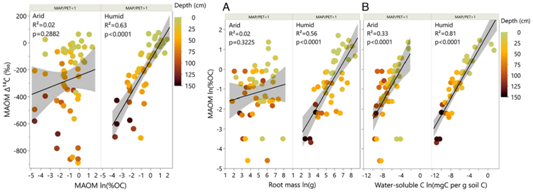
Figure 2 The correlation between MAOM OC(%) and Δ14C(‰), root abundance, and water-soluble carbon concentration in arid and humid climate zones. The OC(%) of MAOM in humid zones shows significant positive correlations with Δ14C(‰), root abundance, and water-soluble carbon concentration, while in arid zones, there is no correlation between OC(%) of MAOM and Δ14C(‰) and root abundance.
(2) Water availability drives the differentiation of soil physicochemical properties, regulating the abundance and persistence of MAOM. The carbon-to-nitrogen ratio is often considered a representative of substrate quality, where higher carbon-to-nitrogen ratios usually indicate fresher substrates with less degradation. As shown in Figure 3, in wet soils, the carbon-to-nitrogen ratio has the highest explanatory power for the abundance of MAOM, and lower persistence of MAOM is closely related to higher carbon-to-nitrogen ratios, indicating that the input of new substrates plays a dominant role in driving lower persistence and lower degradation degrees of MAOM pools. Additionally, in arid soils, higher carbon-to-nitrogen ratios are also associated with increased MAOM, but the correlation is weaker. For a long time, soil texture has been considered one of the favorable variables regulating SOC cycling. However, empirical studies have shown that there are differences in the relative importance of soil texture to organic matter-mineral stabilization mechanisms between arid and humid soil systems. While soil texture is an important physical property for soil carbon cycling, recent studies suggest that the mechanisms of reactive Fe and Al binding with carbon in humid soils and the specific bonding mechanisms of divalent base cations (Ca, Mg) with carbon in arid alkaline soils play a dominant role in determining soil carbon abundance and persistence. These differences in stabilization mechanisms are directly related to the differences in water availability in the two climatic environments and exhibit threshold responses at points where MAP equals PET. The threshold of water availability also corresponds to the changes in soil pH from acidic humid soils to alkaline arid soils. Increased water availability in humid soils accelerates weathering rates, forming secondary Fe and Al mineral phases with different crystallinities, which can form strong inner-layer bonds with organic matter. In arid soils, mineral weathering is limited by moisture content, leading to soils rich in divalent base cations (Ca, Mg), thereby forming cation bridges between minerals and organic matter.
 Figure 3 The correlation between MAOM OC(%) and Δ14C(‰) with soil physicochemical indicators in arid and humid climate zones. The absolute values of the Spearman correlation coefficients of physicochemical indicators of MAOM in humid zones are smaller compared to those in arid zones, where multiple indicators show larger absolute values of the Spearman correlation coefficients with Δ14C.
Figure 3 The correlation between MAOM OC(%) and Δ14C(‰) with soil physicochemical indicators in arid and humid climate zones. The absolute values of the Spearman correlation coefficients of physicochemical indicators of MAOM in humid zones are smaller compared to those in arid zones, where multiple indicators show larger absolute values of the Spearman correlation coefficients with Δ14C.
(3) Combining historical climate and field experiments to predict the rate of change in the stability of MAOM under future climate scenarios. As shown in Figure 4, the trends of abundance and persistence of MAOM under humid climate conditions are consistent with changes in soil depth; however, under arid climate conditions, the trends of abundance and persistence of MAOM with changes in soil depth differ; a turning point occurs at the boundary of MAP/PET=1. This reflects the strong dependence of MAOM abundance and persistence on climate, especially on water availability. With climate change, the stability of MAOM may exhibit nonlinear responses. It is necessary to combine historical climate conditions with the persistence mechanisms of MAOM and field experiments to predict the rate of change in the stability of MAOM under future climate scenarios.
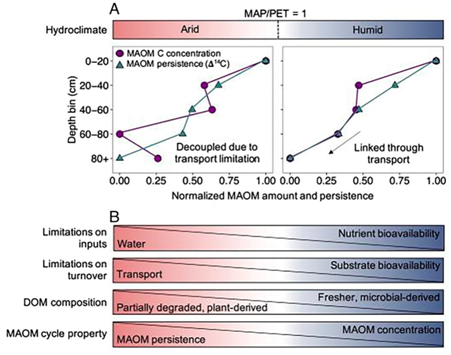 Figure 4 (A) The relationship between the abundance and persistence of MAOM with soil depth in arid and humid climate zones. The abundance and persistence of humid MAOM change consistently with soil depth, while the responses of arid MAOM abundance and persistence to changes in soil depth differ. (B) Input and turnover limiting factors in arid and humid systems and the main factors affecting the composition and cycling of DOM.
Figure 4 (A) The relationship between the abundance and persistence of MAOM with soil depth in arid and humid climate zones. The abundance and persistence of humid MAOM change consistently with soil depth, while the responses of arid MAOM abundance and persistence to changes in soil depth differ. (B) Input and turnover limiting factors in arid and humid systems and the main factors affecting the composition and cycling of DOM.
——Interpreters: Zhang Peng, Liu Yiran







